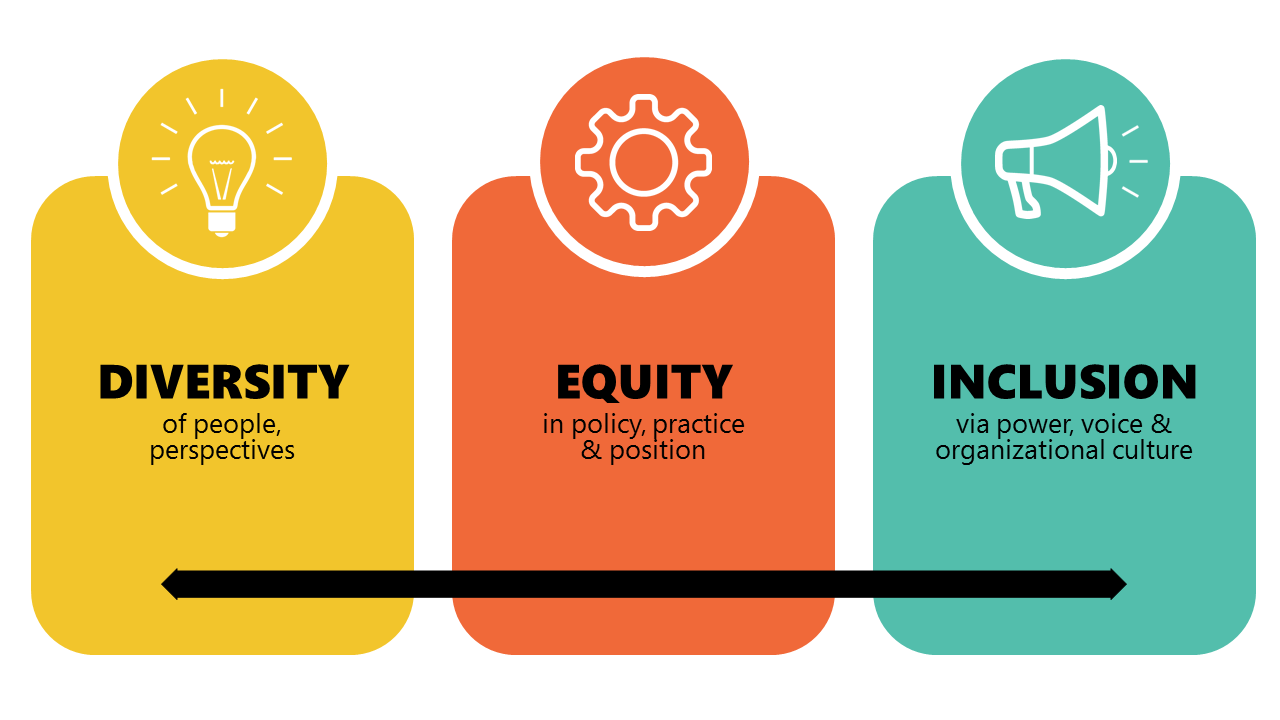Unlocking The Power Of DEI: Diversity, Equity, And Inclusion Targets In Action
Hey there, let’s talk about something that’s not just a buzzword but a game-changer in today’s world—DEI. Diversity, Equity, and Inclusion is more than a catchy phrase; it’s a movement reshaping workplaces and communities worldwide. Whether you're a business leader, HR pro, or just someone curious about how DEI impacts everyday life, this article dives deep into why DEI matters and how setting targets can drive real change. So, buckle up and let’s explore the power of DEI together.
You might be wondering, what exactly does DEI mean? Well, it’s all about creating environments where everyone feels valued, respected, and empowered to contribute their best. This isn’t just about ticking boxes—it’s about fostering a culture where diversity thrives, equity ensures fairness, and inclusion becomes the norm. Companies that get this right aren’t just doing good; they’re also doing well. Studies show that diverse teams outperform homogeneous ones, and inclusive cultures boost employee engagement and retention. Now that’s a win-win situation!
But here’s the thing—DEI isn’t something you achieve overnight. It requires commitment, strategy, and measurable goals. That’s where diversity equity inclusion targets come in. These targets help organizations stay focused, track progress, and hold themselves accountable. Think of them as the GPS guiding your DEI journey. In this article, we’ll break down everything you need to know about setting and achieving these targets, so you can create a more inclusive and equitable world. Ready to dive in? Let’s go!
Understanding the Core of DEI
What Exactly Is DEI?
Alright, let’s start with the basics. DEI stands for Diversity, Equity, and Inclusion. But what do these words really mean? Diversity refers to the variety of differences among people, including race, gender, ethnicity, age, sexual orientation, and more. Equity focuses on fairness and justice, ensuring that everyone has access to the same opportunities, regardless of their background. And inclusion? That’s about creating a sense of belonging, where everyone feels valued and heard. Together, these elements form the foundation of a truly inclusive culture.
Now, here’s the kicker—DEI isn’t just about numbers. It’s about changing mindsets, breaking down barriers, and fostering a culture where everyone can thrive. Companies that embrace DEI aren’t just doing it because it’s the right thing to do; they’re doing it because it makes business sense. Research shows that diverse teams are 35% more likely to outperform their peers, and inclusive cultures lead to better decision-making and innovation. So, if you’re looking to take your organization to the next level, DEI should be at the top of your agenda.
Why DEI Matters in Today’s World
We live in a world that’s more connected than ever before. But with that connectivity comes complexity. Workforces are becoming more diverse, and customers expect brands to reflect the world they live in. That’s why DEI isn’t just a nice-to-have—it’s a must-have. Organizations that fail to embrace diversity risk losing talent, customers, and market share.
But the benefits of DEI go beyond the bottom line. It also creates a more fulfilling workplace where employees feel seen and heard. When people can bring their whole selves to work, they’re more engaged, productive, and innovative. And let’s not forget the social impact. By promoting equity and inclusion, companies can help address systemic inequalities and create a more just society. So, whether you’re looking to boost your business or make a difference in the world, DEI is the key.
Setting Diversity Equity Inclusion Targets
The Importance of Setting Targets
So, you’re on board with DEI. Great! But how do you make it happen? That’s where targets come in. Setting diversity equity inclusion targets helps organizations define what success looks like and how to get there. Think of it as a roadmap for your DEI journey. Without clear targets, it’s easy to lose focus and momentum.
Targets can vary depending on your organization’s needs and goals. Some companies focus on increasing representation of underrepresented groups, while others prioritize improving inclusion scores or closing pay gaps. The key is to make your targets specific, measurable, achievable, relevant, and time-bound (SMART). This ensures that everyone knows what’s expected and how progress will be tracked.
Best Practices for Creating Effective Targets
Creating effective DEI targets isn’t as simple as picking a number and running with it. It requires careful thought and planning. Here are some best practices to consider:
- Involve key stakeholders in the process to ensure buy-in and alignment.
- Set both short-term and long-term targets to balance immediate needs with long-term goals.
- Make your targets transparent and communicate them clearly to employees and stakeholders.
- Regularly review and adjust targets based on progress and changing circumstances.
Remember, targets are just the beginning. The real work happens when you implement strategies to achieve them. This might include recruiting from diverse talent pools, providing unconscious bias training, or creating employee resource groups. The key is to take a holistic approach that addresses all aspects of DEI.
Measuring Success in DEI
Key Metrics to Track
Once you’ve set your targets, it’s time to measure your progress. But what should you be tracking? There are several key metrics that can help you gauge the success of your DEI efforts:
- Representation: How diverse is your workforce across different levels and departments?
- Inclusion: How do employees feel about their sense of belonging and inclusion?
- Equity: Are there pay gaps or barriers to advancement for underrepresented groups?
- Retention: Are you retaining diverse talent, or are they leaving for better opportunities?
Tracking these metrics over time can help you identify areas of strength and opportunities for improvement. It also allows you to celebrate your successes and adjust your strategies as needed.
Tools and Technologies for Monitoring DEI
Thankfully, there are plenty of tools and technologies available to help you monitor your DEI efforts. From HR software that tracks diversity metrics to platforms that provide anonymous feedback on inclusion, there’s no shortage of options. Some popular tools include:
- Workday: A cloud-based HR platform that offers robust reporting and analytics capabilities.
- Glint: An employee engagement platform that provides insights into inclusion and diversity.
- DiversityAnalytics: A tool specifically designed to help organizations track and improve their DEI metrics.
Using these tools can help you gather data more efficiently and make data-driven decisions. But remember, technology is just a tool. The real magic happens when you use it to drive meaningful change.
Overcoming Challenges in DEI
Common Obstacles and How to Address Them
No DEI journey is without its challenges. From resistance to change to lack of resources, there are plenty of obstacles that can derail your efforts. But don’t let that discourage you. Here are some common challenges and how to address them:
- Resistance to Change: Educate employees on the benefits of DEI and involve them in the process to build buy-in.
- Lack of Resources: Prioritize your efforts and focus on high-impact initiatives that align with your goals.
- Data Privacy Concerns: Ensure compliance with data protection laws and be transparent about how data is collected and used.
By addressing these challenges head-on, you can create a more effective and sustainable DEI program.
Building a Culture of Accountability
Accountability is key to the success of any DEI initiative. But how do you create a culture where everyone feels responsible for driving change? It starts with leadership. Leaders must model the behavior they want to see and hold others accountable for meeting DEI targets.
But accountability isn’t just about top-down enforcement. It’s also about empowering employees to take ownership of DEI efforts. This might include creating employee resource groups, encouraging peer feedback, or recognizing and rewarding DEI champions. By fostering a culture of accountability, you can ensure that DEI isn’t just a one-time initiative but a lasting commitment.
Real-World Examples of Successful DEI Programs
Case Study: Company A’s DEI Journey
Let’s take a look at Company A, a tech giant that transformed its culture through a commitment to DEI. By setting ambitious diversity equity inclusion targets and investing in inclusion training, they increased representation of underrepresented groups by 20% in just three years. Their efforts didn’t stop there. They also created employee resource groups, implemented flexible work policies, and launched a mentorship program to support career advancement.
The results speak for themselves. Not only did they improve diversity metrics, but they also saw a significant increase in employee engagement and retention. And the business benefits? A 15% increase in revenue and a reputation as a top employer in the industry. Now that’s what I call a success story!
Lessons Learned from Leading Organizations
What can we learn from organizations like Company A? First, that DEI isn’t a one-size-fits-all solution. Every organization has its own unique challenges and opportunities. Second, that setting targets and tracking progress is crucial to driving change. And finally, that creating a culture of inclusion requires ongoing effort and commitment.
By studying successful DEI programs, we can gain valuable insights into what works and what doesn’t. This can help us avoid common pitfalls and accelerate our own DEI journeys.
Strategies for Sustaining DEI Efforts
Maintaining Momentum Over Time
Sustaining DEI efforts over the long term isn’t easy. It requires a commitment to continuous improvement and a willingness to adapt to changing circumstances. Here are some strategies to help you maintain momentum:
- Regularly review and update your DEI targets to reflect evolving priorities and goals.
- Engage employees in the process by seeking their feedback and involving them in decision-making.
- Celebrate successes and learn from setbacks to keep morale high and motivation strong.
By staying focused and flexible, you can ensure that your DEI efforts remain relevant and impactful.
Fostering a Long-Term Commitment to DEI
DEI isn’t a sprint; it’s a marathon. To make lasting change, organizations must commit to DEI for the long haul. This means embedding DEI into the fabric of your organization, from hiring practices to leadership development. It also means holding leaders accountable for driving change and rewarding those who champion DEI efforts.
Ultimately, DEI is about creating a better future for everyone. By fostering a culture of inclusion and equity, we can build organizations that reflect the diversity of the world we live in and make a positive impact on society. That’s a legacy worth striving for.
Conclusion: The Future of DEI
As we wrap up our journey through the world of diversity equity inclusion targets, it’s clear that DEI is more than just a trend—it’s a necessity. Organizations that embrace DEI aren’t just doing the right thing; they’re also positioning themselves for long-term success. By setting clear targets, measuring progress, and fostering a culture of inclusion, you can create a workplace where everyone feels valued and empowered to contribute their best.
So, what’s next? Take action! Whether it’s setting your first DEI target or refining your existing program, the time to act is now. And don’t forget to share your successes and challenges with others. The more we learn from each other, the stronger our collective DEI efforts will be. Together, we can create a more inclusive and equitable world—one organization at a time. So, what are you waiting for? Let’s get to work!
Table of Contents
- Understanding the Core of DEI
- Setting Diversity Equity Inclusion Targets
- Measuring Success in DEI
- Overcoming Challenges in DEI
- Real-World Examples of Successful DEI Programs
- Strategies for Sustaining DEI Efforts
- Conclusion: The Future of DEI

DEI Diversity Equity Inclusion Matter Symbol. Concept Words DEI

Diversity, Equity, and Inclusion (DEI)

Diversity, Equity, Inclusion And Belonging (DEIB) A 2023, 43 OFF